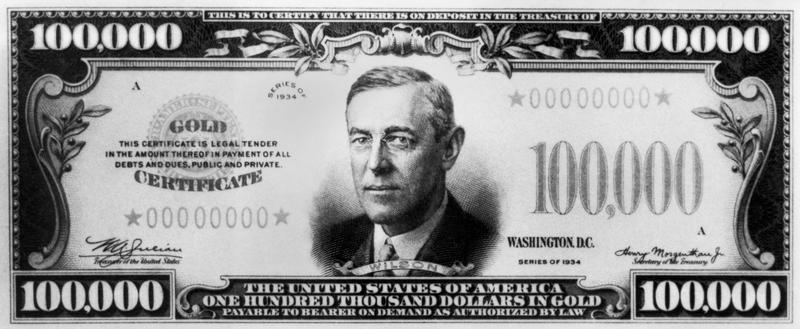It's All About the Wilsons, Baby: Some Curious Historical Facts About U.S. Currency
By | June 9, 2019

Money is something we use on a daily basis, but few know about the more interesting historical aspects of the American currency. This article will discuss some of the more curious aspects of U.S. coins and bills.

Early Americans Hated Paper Money
The new United States issued its first paper currency (Continentals) even before independence in 1775. These notes were overprinted and became devalued. A famous saying was, "Not worth a continental." Instead, individual states issued currency to help support the war effort. The United States would not print paper money again until 1861, during the crisis of the American Civil War.
Nowadays Continental currency is valuable as a collector’s items. A legitimate half dollar Continental, for example, may be auctioned at a valued price of $2,500 dollars or more. Even more valuable were coins.

Early American Coins
Like paper money, the individual colonies produced their own coinage, or used foreign coinage, like the Spanish Piece of Eight as currency. Interestingly, in the early days of the United States, the country still used British currency and used terms such as pence, pound, and shilling. After the implementation of the U.S. Constitution in 1789, the minting of coins became solely a federal activity. The first official U.S. coins were minted at the smallest denomination of a half-cent to the largest denomination of the eagle ($10). Most numismatists, coin experts, hold that the silver half dime, or half disme, was the first coin minted by the United States in 1792. The half dime was eventually replaced by the nickel in 1866.
An interesting note about five cent currency is that paper five-cent notes were issued into the Civil War. The head of the currency bureau, William Clark, attempted to put his image on the note. Congress was so appalled that they replaced his image with that of the explorer Spencer Clark and passed a law forbidding the placement of living persons on any American currency.

The Dollar Sign
The word "dollar" comes the German daler or thaler which is an abbreviation for Joachimstaler which was a silver coin used in Europe through the colonial period. There are multiple theories as to the origin of the dollar symbol. One is that it represents the Pillars of Hercules and was first used in the court of Holy Roman Emperor, King Charles V (1500-1558) as part of his coat of arms. The emperor who owned possessions in the New World, soon had the symbol exported there. Another theory, and probably the correct one, is that it is a transformation of the P and S symbol that was used to represent the Spanish peso, evolved into the dollar symbol which is used today.

Greenbacks
The United States and the Confederate States issued paper money during the Civil War in order to finance the conflict. The Union's currency was nicknamed "Greenback" for its color. The first set of these were demand notes that could be used to obtain the note’s face value in gold or silver. This, however, was insufficient to finance the war, so in 1862 the Union began issuing notes that were not backed by gold or silver but rather by the credit of the government. The value of the greenback veered wildly depending on the fortunes of the war. Its worth was finally stabilized after the war when Congress limited the number of greenbacks that could be printed and it was backed by gold.

Confederate Greybacks
The Confederacy's currency was not backed by hard currency and promised to pay the bearer its value upon the winning of independence by the South. These "greybacks" declined in value because of the losing fortunes of the Confederacy and also because the Southern government overprinted currency. This spawned runaway inflation so confederate paper money was worthless. Today, greybacks have value as collector items. It is notable that many of these bills showed scenes of enslaved African Americans, the slavery issue was central to the war and the Confederate government wanted to emphasize their pro-slavery position.

Big Bucks
The United States issued very high denominations to facilitate bank and governmental money transactions. While high denominations were in use since colonial times, the most famous is first a series of high denomination bills that earned interest which was produced during the Civil War. Second, was a series of gold certificates in values of $100, $1,000, $10,000, and $100,000. These were never issued to the public.
These high denominations are gold and silver certificates. They feature images of former Treasury Secretary and Chief Justice, Salmon Chase ($10,000), James Madison ($5,000), Grover Cleveland ($1,000), and William McKinley ($500). A $100,000 note was also produced featuring Woodrow Wilson. This bill cannot be held legally by collectors.
These high-value bills are no longer produced and have been out of circulation since 1969 and earlier. They are considered obsolete because transfers of monies can be accounted for digitally. Still, it would be nice to find a McKinley or a Madison stuffed between some couch cushions.

Rarest
The rarest U.S. coin is the 1913 Liberty head nickel. This coin was minted from 1883 to 1912 before it was put out of circulation to be replaced by the buffalo nickel. However, in 1913 five Liberty head nickels were struck and fell into the possession of a coin dealer, Samuel W. Brown. Brown, in 1919 advertised that he would buy any such nickels and showed the ones in his possession. This drove up the price with collectors and he made a profit. Brown used to work at the mint in Philadelphia, and it is suspected that he may have orchestrated their production illegally especially since there are no records of the coins' production with the U.S. Mint. All the same, these five coins are incredibly valuable with one selling at auction for $4.5 million in 2018.

